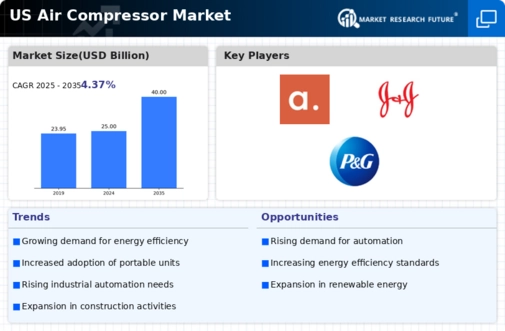Industrial Growth and Demand
The air compressor market is seeing a surge in demand, primarily driven by the expansion of various industrial sectors in the US. Industries such as manufacturing, automotive, and construction are increasingly relying on air compressors for their operations. According to recent data, the manufacturing sector alone accounts for approximately 30% of the total demand for air compressors. This growth is further fueled by the need for efficient and reliable power sources in production processes. As industries modernize and automate, the reliance on compressed air systems is expected to increase, thereby propelling the air compressor market forward. The ongoing industrial growth indicates a robust future for the air compressor market, as companies seek to enhance productivity and operational efficiency.
Energy Efficiency Initiatives
Energy efficiency initiatives are becoming increasingly critical in the air compressor market, as businesses seek to reduce operational costs and environmental impact. The US government has implemented various programs aimed at promoting energy-efficient technologies, which directly influence the air compressor market. For example, the Department of Energy (DOE) has established energy efficiency standards that air compressors must meet, encouraging manufacturers to innovate and produce more efficient models. It is estimated that energy-efficient air compressors can reduce energy consumption by up to 30%, leading to substantial cost savings for businesses. As organizations prioritize sustainability and cost-effectiveness, the demand for energy-efficient air compressors is expected to grow, thereby driving the air compressor market forward.
Rising Demand in Automotive Sector
The automotive sector is a significant driver of growth in the air compressor market, as it relies heavily on compressed air for various applications. From assembly lines to paint shops, air compressors play a crucial role in ensuring efficiency and quality in automotive manufacturing processes. Recent statistics indicate that the automotive industry accounts for nearly 25% of the total air compressor market demand in the US. As the automotive sector continues to evolve with the introduction of electric vehicles and advanced manufacturing techniques, the need for reliable and efficient air compressors is expected to rise. This trend highlights the importance of the automotive sector in shaping the future of the air compressor market, as manufacturers seek to enhance productivity and maintain high standards of quality.
Technological Innovations in Design
Technological innovations in design are reshaping the air compressor market, as manufacturers strive to enhance performance and user experience. Recent advancements in compressor technology, such as variable speed drives and smart controls, are enabling more efficient operation and improved energy management. These innovations not only optimize performance but also reduce maintenance costs, making air compressors more appealing to businesses. The integration of IoT technology is also gaining traction, allowing for real-time monitoring and predictive maintenance. As companies increasingly adopt these advanced technologies, the air compressor market is likely to witness a shift towards more sophisticated and efficient systems. This trend suggests a promising future for the air compressor market, as technological advancements continue to drive growth and innovation.
Regulatory Compliance and Safety Standards
The air compressor market is influenced by stringent regulatory compliance and safety standards in the US. Industries are mandated to adhere to various safety regulations, which often necessitate the use of high-quality air compressors that meet specific performance criteria. For instance, the Occupational Safety and Health Administration (OSHA) has established guidelines that impact the design and operation of air compressors in workplaces. Compliance with these regulations not only ensures worker safety but also enhances operational efficiency. As companies strive to meet these standards, the demand for advanced air compressor systems that comply with safety regulations is likely to rise. This trend indicates a growing market for air compressors that prioritize safety and reliability, thereby shaping the future landscape of the air compressor market.














Leave a Comment